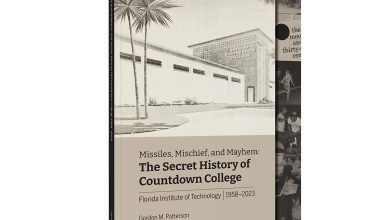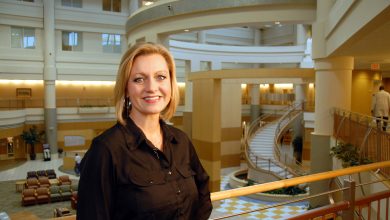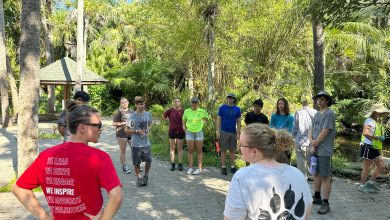Three on Thursday: Madelaine Elam
This week we hear from Madelaine Elam, a recent graduate of the Humanities program who plans to begin her Masters degree at Florida Tech in the spring.
1. What is the last topic you wrote about? If you’re a creative writer, tell us about what inspired your composition. If you’re a student or scholar doing research, explain the context of your piece and what motivated you to choose that topic.
Madelaine: There are three topics on which I have written in the past few months, two non-fiction and one fiction. The non-fiction topic was the Humanities Capstone, in which I discussed the history and evolution of Walt Disney’s EPCOT. Instead of building another Disneyland in the eastern USA, Walt Disney decided to build something bigger and better that would be a lasting legacy: the Experimental Prototype Community of Tomorrow. Walt Disney envisioned a place where people could come together, live, and develop solutions to the past, present, and potential problems of the world. However, after Disney’s death in 1966, the Disney Imagineers (the designers, thinkers, and creative people at Disney) altered the plans for EPCOT, changing it from a Disney’s idea of a permanent World’s Fair to a theme park that would feature an optimistic outlook for the world and its problems by presenting solutions in an entertaining atmosphere, while also showcasing a glimpse at the different cultures of the world. This was the Epcot Center of 1982. Nonetheless, and just as Disney predicted, Epcot was subject to change and has evolved to a theme park that focuses on entertainment with an educational kick. I chose the topic of EPCOT for my Capstone because I am a Florida History enthusiast, and because the history and influence of Disney on Florida’s society and culture was a turning point in the identity of our state and continues to influence its perception.
This project was a challenge, but I learned a lot. For one thing, for a man who lived in a troubled period of American history, Walt Disney was incredibly optimistic. He incorporated this optimism, this hope, into his films and, eventually, his theme park. He believed that the world could be a better place if people knew more about the rest of the world, instead of relying on misleading pieces of information. In the recent months, though, I have had the opportunity to work with Dr. Lelekis on a topic or article that incorporates bits of my Capstone. Earlier this year, the movie Tomorrowland was released by Disney. While many people thought it wasn’t that great, I was bouncing in my seat because I understood some of the connections and references back to Walt Disney’s optimism and dreams of a better world for all. Similarly, within the story of Tomorrowland, there were people, optimistic and smart people, who wanted to make the world a better place; they decided to build this place, the city of Tomorrowland, where they would not be hindered by the politics and rules of the world. When a problem arose in the real world, the people of Tomorrowland would bring a solution to answer or solve the question. This is a reverberating echo of what Walt Disney had intended his EPCOT to be. So, after some discussion, Dr. Lelekis and I have decided to write an article on this, highlighting the similarities between Tomorrowland and Epcot.
My fictional piece is based on the British television show Doctor Who. My friend and I started co-writing this story a few weeks ago. In this story, the Doctor and his friends are off to discover the origins of the Weeping Angels, who have kidnapped the Renaissance artist Michelangelo. I have also written a short Doctor Who blog post for SAC; see it here. Doctor Who lends itself to creative writing and stories like this because the show is not limited to one particular setting or area (such as Castle, a crime fighting duo in New York City, or Grey’s Anatomy in a Seattle hospital, both set in the 21st century), but rather is set in all of time and space – anything could happen!
2. What conclusions or assumptions (right or wrong) might someone make if they looked at the books on your bookshelf/desk/backpack right now? Tell us about some particularly interesting selections and any books you’d recommend to others.
Madelaine: Well, my bookshelves are a fantastic hodge-podge of all sorts of books, but if I’d have to pick a common theme or genre, it would have to be British literature or history. I have Shakespeare, P.L. Travers, Brian Jacques, Arthur Conan Doyle, Clive Staples Lewis, and Jane Austin. I also have a spattering of history books (both fiction and non-fiction), including the Laura Ingalls Wilder books, Harper Lee, Michael Gannon, Gary Mormino, and Michael Grunwald. There is also some children’s/young adult literature that I still enjoy reading as an adult, including Kate DiCamillo, Frank Peretti, Lemony Snicket, and Jeri Massi. I guess people might assume that I am a British literature enthusiast who also enjoys history.
One of my absolutely favorite authors is Brian Jacques, who wrote the Redwall series. While the books feature stories about woodland creatures (mice, moles, squirrels, hares, badgers, etc.) who live in Redwall Abbey in Mossflower Wood, and who occasionally fight the other evil woodland creatures (foxes, weasels, reptiles, cats, etc.), the overarching theme of Jacques books is about ordinary creatures doing extraordinary things; a warrior or hero doesn’t have to be a big, intimidating figure, but rather, he or she can come in any shape or size. While I enjoy that, it is Jacques beautiful and descriptive writing style that really draws me into the world that he has created. Here is an example of Jacques verbal paintings from his first book, Redwall:
3. What or who inspires you when you are feeling creative? Your response doesn’t necessarily have to be about writing. It could be about anything you do to express yourself creatively and the inspiration that fuels that creativity.
Madelaine: I frequently get my creative writing spark from looking at places around the world throughout history and wondering what I would do if I lived in that time and place. I was a fan of the American Girl books (not the dolls) when I was young, which may have fostered that way of thinking. There are times when I read history textbooks that I ask myself, “Self, what would a kid like me be doing during this time period?” That usually leads me down a rabbit hole of research and imagination.
As a musician, creativity comes in different methods. I am usually playing with my friends during a music practice when the spark of creativity ignites an idea. My friend Bethany Soule and I came up with a piece recently that is a great example of this. It is a medley of the hymn “This is My Father’s World” and Howard Shore’s “Concerning Hobbits”. When Howard Shore wrote the music to the Lord of the Rings and Hobbit movies, it seems that he borrowed the first seven notes from the hymn. Eventually, Bethany and I wrote and pieced together this arrangement, combining various parts from each piece of music, as well as different musical techniques on each instrument. For example, I used the harp technique of playing close to the soundboard (p.d.l.t.), which produces a woody or mandolin-y sound, a sound that fits in well with the music of the Shire. After a few hours of testing out different combinations, Bethany and I had our medley, but we couldn’t figure out a name for it. The night of the event, however, the master of ceremonies solved that problem and introduced it as “This is My Father’s Middle Earth,” which resulted in much and very hearty laughter. We hope you enjoy this piece!








